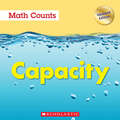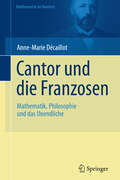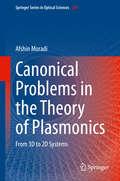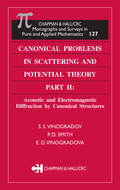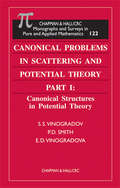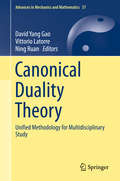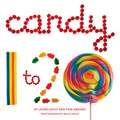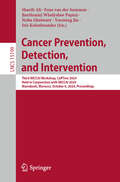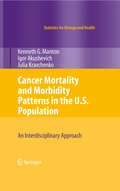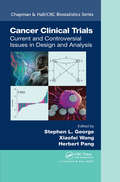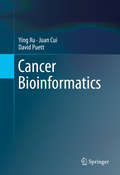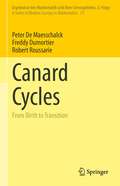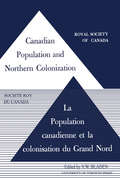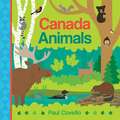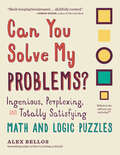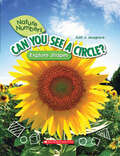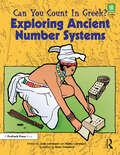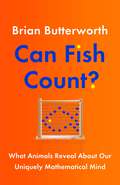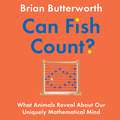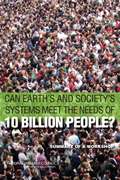- Table View
- List View
Capacity (Math Counts: Updated Editions)
by Henry PluckroseAn introduction to capacity for the youngest readers!Math Counts series introduces young readers (grades K-3) to early math concepts. Real-world examples and corresponding photos make math concepts easy to grasp.Capacity is the word used to describe the most that a container can hold.
Cantor und die Franzosen: Mathematik, Philosophie und das Unendliche (Mathematik im Kontext)
by Anne-Marie Décaillot Klaus VolkertEnde des 19. Jahrhunderts, als Georg Cantor in Halle die Mengenlehre entwickelte, korrespondierte der Mathematiker lebhaft mit zahlreichen französischen Fachkollegen. Diese Briefe nimmt die Autorin zur Grundlage, um im Detail zu beschreiben, wie die Briefpartner um mathematische Begriffe gerungen haben. Eingebettet in den historischen Kontext wird so ein faszinierender Moment in der Geschichte der Mathematik wieder lebendig.
Canonical Ramsey Theory on Polish Spaces
by Vladimir Kanovei Marcin Sabok Jindřich ZapletalThis book lays the foundations for an exciting new area of research in descriptive set theory. It develops a robust connection between two active topics: forcing and analytic equivalence relations. This in turn allows the authors to develop a generalization of classical Ramsey theory. Given an analytic equivalence relation on a Polish space, can one find a large subset of the space on which it has a simple form? The book provides many positive and negative general answers to this question. The proofs feature proper forcing and Gandy-Harrington forcing, as well as partition arguments. The results include strong canonization theorems for many classes of equivalence relations and sigma-ideals, as well as ergodicity results in cases where canonization theorems are impossible to achieve. Ideal for graduate students and researchers in set theory, the book provides a useful springboard for further research.
Canonical Problems in the Theory of Plasmonics: From 3D to 2D Systems (Springer Series in Optical Sciences #230)
by Afshin MoradiThis book provides a systemic and self-contained guide to the theoretical description of the fundamental properties of plasmonic waves. The field of plasmonics is built on the interaction of electromagnetic radiation and conduction electrons at metallic interfaces or in metallic nanostructures, and so to describe basic plasmonic behavior, boundary-value problems may be formulated and solved using electromagnetic wave theory based on Maxwell’s equations and the electrostatic approximation.In preparation, the book begins with the basics of electromagnetic and electrostatic theories, along with a review of the local and spatial nonlocal plasma model of an electron gas. This is followed by clear and detailed boundary value analysis of both classical three-dimensional and novel two-dimensional plasmonic systems in a range of different geometries. With only general electromagnetic theory as a prerequisite, this resulting volume will be a useful entry point to plasmonic theory for students, as well as a convenient reference work for researchers who want to see how the underlying models can be analysed rigorously.
Canonical Problems in Scattering and Potential Theory Part II: Acoustic and Electromagnetic Diffraction by Canonical Structures (Monographs And Surveys In Pure And Applied Mathematics Ser.)
by S.S. Vinogradov P. D. Smith E.D. VinogradovaAlthough the analysis of scattering for closed bodies of simple geometric shape is well developed, structures with edges, cavities, or inclusions have seemed, until now, intractable to analytical methods. This two-volume set describes a breakthrough in analytical techniques for accurately determining diffraction from classes of canonical scatterers
Canonical Problems in Scattering and Potential Theory Part 1: Canonical Structures in Potential Theory
by S.S. Vinogradov P. D. Smith E.D. VinogradovaAlthough the analysis of scattering for closed bodies of simple geometric shape is well developed, structures with edges, cavities, or inclusions have seemed, until now, intractable to analytical methods. This two-volume set describes a breakthrough in analytical techniques for accurately determining diffraction from classes of canonical scatterers
Canonical Duality Theory: Unified Methodology for Multidisciplinary Study (Advances in Mechanics and Mathematics #37)
by Ning Ruan David Yang Gao Vittorio LatorreThis book on canonical duality theory provides a comprehensive review of its philosophical origin, physics foundation, and mathematical statements in both finite- and infinite-dimensional spaces. A ground-breaking methodological theory, canonical duality theory can be used for modeling complex systems within a unified framework and for solving a large class of challenging problems in multidisciplinary fields in engineering, mathematics, and the sciences. This volume places a particular emphasis on canonical duality theory's role in bridging the gap between non-convex analysis/mechanics and global optimization. With 18 total chapters written by experts in their fields, this volume provides a nonconventional theory for unified understanding of the fundamental difficulties in large deformation mechanics, bifurcation/chaos in nonlinear science, and the NP-hard problems in global optimization. Additionally, readers will find a unified methodology and powerful algorithms for solving challenging problems in complex systems with real-world applications in non-convex analysis, non-monotone variational inequalities, integer programming, topology optimization, post-buckling of large deformed structures, etc. Researchers and graduate students will find explanation and potential applications in multidisciplinary fields.
Candy 1 to 20
by Pam Abrams Bruce Wolf Laurie WolfReaders will devour this delicious counting book from lollipops to licorice strings, from 1 to 20!
Cancer Prevention, Detection, and Intervention: Third MICCAI Workshop, CaPTion 2024, Held in Conjunction with MICCAI 2024, Marrakesh, Morocco, October 6, 2024, Proceedings (Lecture Notes in Computer Science #15199)
by Sharib Ali Fons van der Sommen Bartłomiej Władysław Papież Yueming Jin Iris Kolenbrander Noha GhatwaryThis book constitutes the refereed proceedings of the Third International Workshop on Cancer Prevention Through Early Detection, CaPTion, held in conjunction with the 27th International Conference on Medical Imaging and Computer-Assisted Intervention, MICCAI 2024, in Marrakesh, Morocco, on October 6, 2024. The 22 full papers presented in this book were carefully reviewed and selected from 25 submissions. They were organized in topical sections as follows: Classification and characterization; detection and segmentation; cancer/early cancer detection, treatment and survival prognosis.
Cancer Mortality and Morbidity Patterns in the U.S. Population: An Interdisciplinary Approach (Statistics for Biology and Health)
by Julia Kravchenko Igor Akushevich K. G. MantonThe purpose of this book is to examine the etiology of cancer in large human populations using mathematical models developed from an inter-disciplinary perspective of the population epidemiological, biodemographic, genetic and physiological basis of the mechanisms of cancer initiation and progression. In addition an investigation of how the basic mechanism of tumor initiation relates to general processes of senescence and to other major chronic diseases (e.g., heart disease and stroke) will be conducted.
Cancer Clinical Trials: Current and Controversial Issues in Design and Analysis (Chapman & Hall/CRC Biostatistics Series #91)
by Xiaofei Wang Stephen L. George Herbert PangCancer Clinical Trials: Current and Controversial Issues in Design and Analysis provides statisticians with an understanding of the critical challenges currently encountered in oncology trials. Well-known statisticians from academic institutions, regulatory and government agencies (such as the U.S. FDA and National Cancer Institute), and the pharmaceutical industry share their extensive experiences in cancer clinical trials and present examples taken from actual trials. The book covers topics that are often perplexing and sometimes controversial in cancer clinical trials. Most of the issues addressed are also important for clinical trials in other settings. After discussing general topics, the book focuses on aspects of early and late phase clinical trials. It also explores personalized medicine, including biomarker-based clinical trials, adaptive clinical trial designs, and dynamic treatment regimes.
Cancer Bioinformatics
by Ying Xu Juan Cui David PuettThis book provides a framework for computational researchers studying the basics of cancer through comparative analyses of omic data. It discusses how key cancer pathways can be analyzed and discovered to derive new insights into the disease and identifies diagnostic and prognostic markers for cancer. Chapters explain the basic cancer biology and how cancer develops, including the many potential survival routes. The examination of gene-expression patterns uncovers commonalities across multiple cancers and specific characteristics of individual cancer types. The authors also treat cancer as an evolving complex system, explore future case studies, and summarize the essential online data sources. Cancer Bioinformatics is designed for practitioners and researchers working in cancer research and bioinformatics. It is also suitable as a secondary textbook for advanced-level students studying computer science, biostatistics or biomedicine.
Canard Cycles: From Birth to Transition (Ergebnisse der Mathematik und ihrer Grenzgebiete. 3. Folge / A Series of Modern Surveys in Mathematics #73)
by Freddy Dumortier Robert Roussarie Peter De MaesschalckThis book offers the first systematic account of canard cycles, an intriguing phenomenon in the study of ordinary differential equations. The canard cycles are treated in the general context of slow-fast families of two-dimensional vector fields. The central question of controlling the limit cycles is addressed in detail and strong results are presented with complete proofs.In particular, the book provides a detailed study of the structure of the transitions near the critical set of non-isolated singularities. This leads to precise results on the limit cycles and their bifurcations, including the so-called canard phenomenon and canard explosion. The book also provides a solid basis for the use of asymptotic techniques. It gives a clear understanding of notions like inner and outer solutions, describing their relation and precise structure.The first part of the book provides a thorough introduction to slow-fast systems, suitable for graduate students. The second and third parts will be of interest to both pure mathematicians working on theoretical questions such as Hilbert's 16th problem, as well as to a wide range of applied mathematicians looking for a detailed understanding of two-scale models found in electrical circuits, population dynamics, ecological models, cellular (FitzHugh–Nagumo) models, epidemiological models, chemical reactions, mechanical oscillators with friction, climate models, and many other models with tipping points.
Canadian Population and Northern Colonization/La Population canadienne et al colonisation du Grand Nord: Symposium presented to the Royal Society of Canada/Colloque presente a la Societe Royale du Canada (Royal Society of Canada Studia Varia Series #no. 8)
by V. W. BladenIn their annual sessions the various Sections of the Royal Society are accustomed to take up for general discussion a topic of current interest and this gives Fellows and special guests from the natural sciences, the social sciences, and the humanities an opportunity for useful communication across the disciplines on an important subject.<P><P>In 1961 the topic was an especially vital issue, the population explosion, and this volume, based on the papers given at the meeting, has much valuable information and many pertinent and provocative comments on this phenomenon particularly as it affects Canada.<P>T.W.M. Cameron leads off with a general background on the causes and consequences of the population increase around the world. Then come a group of papers presenting various aspects of the population in Canada's settled areas. Pierre Dagenais studies the growth in that population in recent years; Guy Rocher presents developments in our labour force in the 1900's with particular reference to the older age group, to women, and to the unemployed; Jacques Henripin describes ethnic and linguistic patterns over the country; Nathan Keyfitz outlines new patterns in the birth rate and their significance. A.R.M. Lower concludes this portion of the book with a lively historical study of the effects of natural increase and waves of immigration in the French and English periods, leading on to our present "bold experiment" in Canada which assumes the "risks of a non-homogeneous, non-integral society with every value fighting it out for survival."<P>The second part of the book turns to those largely unsettled areas stretching away in Canada's north and considers the potentialities of these areas as a more permanent habitat for man. With an introduction by René Pomerleau, various problems of settlement are brought forward. W. Keith Buck and D.J.F. Henderson discuss economic aspects of mineral development in the north; E.W. Humphrys, the possible use of atomic energy as a way of coping with fuel and supply; M.J. Dunbar, the prospects of support for a new population in the use natural resources contributed by the land and the sea; G. Malcolm Brown, problems of man's acclimatization to life in a colder climate; Trevor Lloyd, the kind of settlement in the Far North which is desirable and possible given its special conditions of subsistence and transportation and economic activity. All these authors stress that any planning for a northern future "must be based on a broad, systematic and thorough scientific appraisal."<P>This is an important and absorbing book and it will give both specialist and general reader much to think about.
Canada Animals
by Paul CovelloThe latest title in Paul Covello’s winning Canada board-book series features wondrously detailed illustrations for the very young, highlighting some of Canada’s most beloved and iconic creatures. From the author and illustrator of the national bestsellers Canada ABC and Canada 123.
Can You Solve My Problems?: Ingenious, Perplexing, And Totally Satisfying Math And Logic Puzzles (Alex Bellos Puzzle Books #0)
by Alex BellosPuzzle lovers, rejoice! Bestselling math writer Alex Bellos has a challenge for you: 125 of the world’s best brainteasers from the last two millennia. Armed with logic alone, you’ll detect counterfeit coins, navigate river crossings, and untangle family trees. Then—with just a dash of high school math—you’ll tie a rope around the Earth, match wits with a cryptic wizard, and use four 4s to create every number from 1 to 50. (It can be done!) The ultimate casebook for daring puzzlers, Can You Solve My Problems? also tells the story of the puzzle—from ancient China to Victorian England to modern-day Japan. Grab your pencil and get puzzling!
Can You See a Circle?: Explore Shapes (Nature Numbers)
by Ruth MusgraveIn Nature Numbers, math is beautiful, recognizable, and all around us! Highly engaging pictures of animals and nature scenes, along with cool chalk illustrations, are used to introduce basic math concepts and encourage kids to see a world of numbers all around them.K-2 math concepts include learning about shapes. This book explores shapes in nature with amazing nature pictures and chalk illustrations!
Can You Count to a Googol?
by Robert E WellsYou may be able to count all the way to one hundred, but have you ever counted to a googol? It's impossible! In this fun book of numbers, Robert E. Wells explores the wonderful world of zeros and tells how the googol came to be named.
Can You Count in Greek?: Exploring Ancient Number Systems (Grades 5-8)
by Judy Leimbach Kathy LeimbachDiscovering the way people in ancient cultures conducted their lives is fascinating for young people, and learning how these people counted and calculated is a part of understanding these cultures. This book offers a concise, but thorough, introduction to ancient number systems. Students won't just learn to count like the ancient Greeks; they'll learn about the number systems of the Mayans, Babylonians, Egyptians, and Romans, as well as learning Hindu-Arabic cultures and quinary and binary systems. Symbols and rules regarding the use of the symbols in each number system are introduced and demonstrated with examples. Activity pages provide problems for the students to apply their understanding of each system. Can You Count in Greek? is a great resource for math, as well as a supplement for social studies units on ancient civilizations. This valuable resource builds understanding of place value, number theory, and reasoning. It includes everything you need to easily incorporate these units in math or social studies classes. Whether you use all of the units or a select few, your students will gain a better understanding and appreciation of our number system.Grades 5-8
Can Fish Count?: What Animals Reveal about our Uniquely Mathematical Mind
by Brian Butterworth'What I like best about this fascinating book is the detail. Brian Butterworth doesn't just tell us stories of animals with numerical abilities: he tells us about the underlying science. Elegantly written and a joy to read' - Professor Ian Stewart, author of What's the Use? and Taming the Infinite'Full of thought-provoking studies and animal observations' - Booklist'Enlightening and entertaining' - Publishers WeeklyThe Hidden Genius of Animals: Every pet owner thinks their own dog, cat, fish or hamster is a genius. What makes CAN FISH COUNT? so exciting is the way it unveils just how widespread intelligence is in nature. Pioneering psychologist Brian Butterworth describes the extraordinary numerical feats of all manner of species ranging from primates and mammals to birds, reptiles, fish and insects. Whether it's lions deciding to fight or flee, frogs competing for mates, bees navigating their way to food sources, fish assessing which shoal to join, or jackdaws counting friends when joining a mob - every species shares an ability to count.Homo Sapiens may think maths is our exclusive domain, but this book shows that every creature shares a deep-seated Darwinian ability to understand the intrinsic language of our universe: mathematics CAN FISH COUNT? is that special sort of science book - a global authority in his field writing an anecdotally-rich and revelatory narrative which changes the way you perceive something we take for granted.
Can Fish Count?: What Animals Reveal about our Uniquely Mathematical Mind
by Brian ButterworthEvery pet owner thinks their own dog, cat, fish or hamster is a genius. What makes CAN FISH COUNT? so exciting is the way it unveils just how widespread intelligence is in nature. Pioneering psychologist Brian Butterworth describes the extraordinary numerical feats of all manner of species ranging from primates and mammals to birds, reptiles, fish and insects. Whether it's lions deciding to fight or flee, frogs competing for mates, bees navigating their way to food sources, fish assessing which shoal to join, or jackdaws counting friends when joining a mob - every species shares an ability to count.Homo Sapiens may think maths is our exclusive domain, but this book shows that every creature shares a deep-seated Darwinian ability to understand the intrinsic language of our universe: mathematics CAN FISH COUNT? is that special sort of science book - a global authority in his field writing an anecdotally-rich and revelatory narrative which changes the way you perceive something we take for granted.(P)2022 Quercus Editions Limited
Can Fish Count?: What Animals Reveal About Our Uniquely Mathematical Minds
by Brian ButterworthAn entertaining investigation of the numerical abilities of animals and our own appetite for arithmetic The philosopher Bertrand Russell once observed that realizing that a pair of apples and the passage of two days could somehow both be represented by the concept we call &“two&” was one of the most astonishing discoveries anyone had ever made. So what do we make of the incredible fact that animals seem to have inherent mathematical abilities? As cognitive psychologist Brian Butterworth shows us in Can Fish Count?, many &“simple&” animals—such as bees, which count trees and fence posts, and guppies, which can size up groups—have a sense of numbers. And unlike humans, they don&’t need to be taught. In telling animals&’ stories, Butterworth shines new light on one of our most ancient questions: Just where, exactly, do numbers come from? He reveals how insights gleaned from studying animals can help us make better sense of our own abilities. Full of discovery and delight, Can Fish Count? is an astonishing journey through the animal kingdom and the human mind.
Can Earth's and Society's Systems Meet the Needs of 10 Billion People?: Summary of a Workshop
by Maureen MellodyThe Earth's population, currently 7. 2 billion, is expected to rise at a rapid rate over the next 40 years. Current projections state that the Earth will need to support 9. 6 billion people by the year 2050, a figure that climbs to nearly 11 billion by the year 2100. At the same time, most people envision a future Earth with a greater average standard of living than we currently have - and, as a result, greater consumption of our planetary resources. How do we prepare our planet for a future population of 10 billion? How can this population growth be achieved in a manner that is sustainable from an economic, social, and environmental perspective? Can Earth's and Society's Systems Meet the Needs of 10 Billion People? is the summary of a multi-disciplinary workshop convened by the National Academies in October 2013 to explore how to increase the world's population to 10 billion in a sustainable way while simultaneously increasing the well-being and standard of living for that population. This report examines key issues in the science of sustainability that are related to overall human population size, population growth, aging populations, migration toward cities, differential consumption, and land use change, by different subpopulations, as viewed through the lenses of both social and natural science.
Campus Sex Assaults
by Chicago Tribune StaffIn September 2010, St. Mary's College freshman Elizabeth "Lizzy" Seeberg was found dead, a victim of an apparent suicide from prescription medication, mere days after alleging she had been sexually attacked by a Notre Dame football player. Starting in November of that year, the Chicago Tribune began reporting on this case that was up until that point not publicly acknowledged by the University of Notre Dame. Over the course of the next year, Tribune journalists and investigators produced a series of articles focusing on this case--and the cases of other sexual assault victims on Midwestern university campuses7mdash;leading to new investigations and subsequent reforms at schools across the region.Campus Sexual Assaults is a gripping and important piece of investigative journalism, revealing disturbing primary materials from cases and shocking personal interviews with the victims. The yearlong investigation shed light on the antiquated and obfuscated reporting and prosecuting practices of major Midwest colleges and universities, going so far as to discover that Notre Dame campus authorities did not even promptly investigate the alleged assault that occurred days before Lizzy Seeberg's death. Campus Sexual Assaults goes on to investigate similar trends in under-reporting and under-prosecuting sexual assaults on campuses across the country.Part 1 of Campus Sexual Assaults reports on the Seeberg case as it unfolded, and ends with the county prosecutor's decision that there would be no charges, since the victim's death made her statements inadmissible in court. Part 2 has a wider focus, as the Tribune reports on another similar attack at Notre Dame and a survey finding that few people accused of sexual violence on college campuses are ever convicted. Part 3 deals with reforms at Notre Dame and similar problems at Marquette University.The powerful stories told in Campus Sexual Assaults by the survivors and families victimized by these attacks are moving as much as they can be upsetting. After months of reporting and research on the Seeberg case and others like it, the Tribune's investigations sparked new legal investigations and subsequent reforms at the campuses in question. This collection of articles and investigative reports is a touching, in-depth look at an endemic problem at universities across America and should be required reading for not only campus and sexual health educators, but for university audiences and concerned readers everywhere.
Cambridge Tracts In Mathematics
by R. M. GreenMinuscule representations occur in a variety of contexts in mathematics and physics. They are typically much easier to understand than representations in general, which means they give rise to relatively easy constructions of algebraic objects such as Lie algebras and Weyl groups. This book describes a combinatorial approach to minuscule representations of Lie algebras using the theory of heaps, which for most practical purposes can be thought of as certain labelled partially ordered sets. This leads to uniform constructions of (most) simple Lie algebras over the complex numbers and their associated Weyl groups, and provides a common framework for various applications. The topics studied include Chevalley bases, permutation groups, weight polytopes and finite geometries. Ideal as a reference, this book is also suitable for students with a background in linear and abstract algebra and topology. Each chapter concludes with historical notes, references to the literature and suggestions for further reading.
